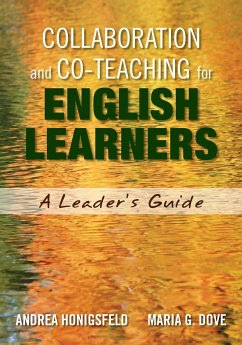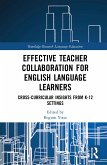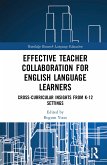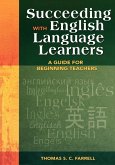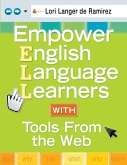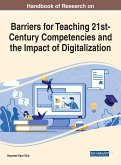- Broschiertes Buch
- Merkliste
- Auf die Merkliste
- Bewerten Bewerten
- Teilen
- Produkt teilen
- Produkterinnerung
- Produkterinnerung
Your English Language Learners are counting on you to collaborate effectively. The Common Core State Standards have increased the pressure on English Language Learners. And with the EL population increasing every day, schools
Andere Kunden interessierten sich auch für
![Effective Teacher Collaboration for English Language Learners Effective Teacher Collaboration for English Language Learners]() Effective Teacher Collaboration for English Language Learners53,99 €
Effective Teacher Collaboration for English Language Learners53,99 €![Effective Teacher Collaboration for English Language Learners Effective Teacher Collaboration for English Language Learners]() Effective Teacher Collaboration for English Language Learners167,99 €
Effective Teacher Collaboration for English Language Learners167,99 €![Succeeding with English Language Learners Succeeding with English Language Learners]() Thomas S. C. FarrellSucceeding with English Language Learners30,99 €
Thomas S. C. FarrellSucceeding with English Language Learners30,99 €![Empower English Language Learners with Tools from the Web Empower English Language Learners with Tools from the Web]() Lori Langer de RamirezEmpower English Language Learners with Tools from the Web39,99 €
Lori Langer de RamirezEmpower English Language Learners with Tools from the Web39,99 €![The Co-Teaching Power Zone The Co-Teaching Power Zone]() Elizabeth SteinThe Co-Teaching Power Zone171,99 €
Elizabeth SteinThe Co-Teaching Power Zone171,99 €![Handbook of Research on Barriers for Teaching 21st-Century Competencies and the Impact of Digitalization Handbook of Research on Barriers for Teaching 21st-Century Competencies and the Impact of Digitalization]() Handbook of Research on Barriers for Teaching 21st-Century Competencies and the Impact of Digitalization246,99 €
Handbook of Research on Barriers for Teaching 21st-Century Competencies and the Impact of Digitalization246,99 €![School-University-Community Collaboration for Civic Education and Engagement in the Democratic Project School-University-Community Collaboration for Civic Education and Engagement in the Democratic Project]() R. Martin ReardonSchool-University-Community Collaboration for Civic Education and Engagement in the Democratic Project63,99 €
R. Martin ReardonSchool-University-Community Collaboration for Civic Education and Engagement in the Democratic Project63,99 €-
-
-
Your English Language Learners are counting on you to collaborate effectively. The Common Core State Standards have increased the pressure on English Language Learners. And with the EL population increasing every day, schools
Produktdetails
- Produktdetails
- Verlag: Corwin
- Seitenzahl: 176
- Erscheinungstermin: 20. November 2014
- Englisch
- Abmessung: 254mm x 178mm x 10mm
- Gewicht: 344g
- ISBN-13: 9781452241968
- ISBN-10: 1452241961
- Artikelnr.: 41354486
- Herstellerkennzeichnung
- Libri GmbH
- Europaallee 1
- 36244 Bad Hersfeld
- gpsr@libri.de
- Verlag: Corwin
- Seitenzahl: 176
- Erscheinungstermin: 20. November 2014
- Englisch
- Abmessung: 254mm x 178mm x 10mm
- Gewicht: 344g
- ISBN-13: 9781452241968
- ISBN-10: 1452241961
- Artikelnr.: 41354486
- Herstellerkennzeichnung
- Libri GmbH
- Europaallee 1
- 36244 Bad Hersfeld
- gpsr@libri.de
Andrea Honigsfeld, EdD, is a professor in the School of Education at Molloy College, Rockville Centre, New York. Before entering the field of teacher education, she was an English-as-a-foreign-language teacher in Hungary (Grades 5-8 and adult) and an English-as-a-second-language teacher in New York City (Grades K-3 and adult). She also taught Hungarian at New York University. She was the recipient of a doctoral fellowship at St. John's University, New York, where she conducted research on individualized instruction. She has published extensively on working with multilingual learners and teacher collaboration. She received a Fulbright Award to lecture in Iceland in the fall of 2002. In the past 22 years, she has been presenting at conferences across the United States, China, Denmark, Japan, the Philippines, Sweden, Thailand, the United Kingdom, and the United Arab Emirates. She coauthored Differentiated Instruction for At-Risk Students (2009) and coedited the five-volume Breaking the Mold of Education series (2010-2013), published by Rowman and Littlefield. She is also the coauthor of Core Instructional Routines: Go-To Structures for Effective Literacy Teaching, K-5 and 6-12 (2014), Growing Language and Literacy (K-8 and 6-12, 2019, 2024 respectively) published by Heinemann. With Maria G. Dove, she coedited Coteaching and Other Collaborative Practices in the EFL/ESL Classroom: Rationale, Research, Reflections, and Recommendations (2012), Co-teaching for English Learners: Evidence-based Practices and Research-informed Outcomes (2020), Portraits of collaboration: Educators working together to support multilingual learners (2022), and coauthored Collaboration and Co-Teaching: Strategies for English Learners (2010), Common Core for the Not-So-Common Learner, Grades K-5: English Language Arts Strategies (2013), Common Core for the Not-So-Common Learner, Grades 6-12: English Language Arts Strategies (2013), Beyond Core Expectations: A Schoolwide Framework for Serving the Not-So-Common Learner (2014), Collaboration and Co-Teaching: A Leader's Guide (2015), Co-Teaching for English Learners: A Guide to Collaborative Planning, Instruction, Assessment, and Reflection (2018), Collaborating for English Learners: A Foundational Guide to Integrated Practices (2019), and Co-Planning: 5 Essential Practices to Integrate Curriculum and Instruction for English Learners (2022). She is a contributing author of Breaking Down the Wall: Essential Shifts for English Learner Success (2020), From Equity Insights to Action (2021), Digital-Age Teaching for English Learners (2022), Collaboration and Co-teaching for D ual Language Learners: Transforming Programs for Multilingualism and E quity (2023), Breaking Down the Monolingual Wall: Essential Shifts for Multilingual Learners' Success (2024). Collaboration for Multilingual Learners with Exceptionalities: We Share the Students (2024), Collaborative Assessment for Multilingual Learners and Teachers: Pathways to Partnerships (2025), 9 Dimensions of Scaffolding for Multilingual Learners. Ten of her Corwin books are bestsellers.
Preface
Acknowledgements
About the Authors
1. Why Do Collaborative Services Make Sense for English Language Learners?
2. What Are Collaborative Program Models to Serve ELLs?
3. How Do You Support Shared Curriculum Development and Implementation for
the Sake of ELLs?
4. How Do You Support Collaborative Instructional and Assessment Practices
for ELLs?
5. What Are the Nuts and Bolts of Coordinating Collaborative Teaching for
ELLs?
6. What Type of Professional Learning Is Needed to Work with ELLs
Effectively?
7. What Type of Leadership is Needed for Integrated, Collaborative Schools?
References
Acknowledgements
About the Authors
1. Why Do Collaborative Services Make Sense for English Language Learners?
2. What Are Collaborative Program Models to Serve ELLs?
3. How Do You Support Shared Curriculum Development and Implementation for
the Sake of ELLs?
4. How Do You Support Collaborative Instructional and Assessment Practices
for ELLs?
5. What Are the Nuts and Bolts of Coordinating Collaborative Teaching for
ELLs?
6. What Type of Professional Learning Is Needed to Work with ELLs
Effectively?
7. What Type of Leadership is Needed for Integrated, Collaborative Schools?
References
Preface
Acknowledgements
About the Authors
1. Why Do Collaborative Services Make Sense for English Language Learners?
2. What Are Collaborative Program Models to Serve ELLs?
3. How Do You Support Shared Curriculum Development and Implementation for
the Sake of ELLs?
4. How Do You Support Collaborative Instructional and Assessment Practices
for ELLs?
5. What Are the Nuts and Bolts of Coordinating Collaborative Teaching for
ELLs?
6. What Type of Professional Learning Is Needed to Work with ELLs
Effectively?
7. What Type of Leadership is Needed for Integrated, Collaborative Schools?
References
Acknowledgements
About the Authors
1. Why Do Collaborative Services Make Sense for English Language Learners?
2. What Are Collaborative Program Models to Serve ELLs?
3. How Do You Support Shared Curriculum Development and Implementation for
the Sake of ELLs?
4. How Do You Support Collaborative Instructional and Assessment Practices
for ELLs?
5. What Are the Nuts and Bolts of Coordinating Collaborative Teaching for
ELLs?
6. What Type of Professional Learning Is Needed to Work with ELLs
Effectively?
7. What Type of Leadership is Needed for Integrated, Collaborative Schools?
References

